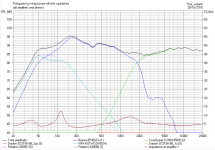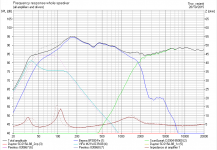Hello, I have a question about a choice I've to do on the design of a sub in single vented bandpass design to be obtained within a remodeled existing cabinet.
The existing volume is 28 liters, the choice concerns the driver to use. Consider two drivers of opposite type, one with high Vas and low Qts (let's call it "A", eg. Vifa M21WO39-08 with Vas 105 liters and Qts 0.30) and one with low Vas and high Qts (let's call it "B", eg. Peerless with 830667 with Vas 33 liters and Qts 0.54).
Take the case of them work in bass reflex: to their characteristics the optimum volume for a maximally flat alignment should look like about 50-55 liters. Here's the question:
What happens to answer if I compel drivers to work in a volume almost halved? Which one performs better, the driver "A" or the drivers "B"? Or if you want, which means less worse?
Here's the other question:
What has just been discharged continues to remain valid in the case where instead bass reflex are made to work in a single vented bandpass design? Specifically, it is a 12 liters internal + 16 external tuned to 65 Hz.
Based on what I know in a smaller volume should behave better a driver with low Qts for the better behavior for impulses, but I also know that for a symmetrical load is better a driver with high Qts....
What would you recommend?
Many thanks!
The existing volume is 28 liters, the choice concerns the driver to use. Consider two drivers of opposite type, one with high Vas and low Qts (let's call it "A", eg. Vifa M21WO39-08 with Vas 105 liters and Qts 0.30) and one with low Vas and high Qts (let's call it "B", eg. Peerless with 830667 with Vas 33 liters and Qts 0.54).
Take the case of them work in bass reflex: to their characteristics the optimum volume for a maximally flat alignment should look like about 50-55 liters. Here's the question:
What happens to answer if I compel drivers to work in a volume almost halved? Which one performs better, the driver "A" or the drivers "B"? Or if you want, which means less worse?
Here's the other question:
What has just been discharged continues to remain valid in the case where instead bass reflex are made to work in a single vented bandpass design? Specifically, it is a 12 liters internal + 16 external tuned to 65 Hz.
Based on what I know in a smaller volume should behave better a driver with low Qts for the better behavior for impulses, but I also know that for a symmetrical load is better a driver with high Qts....
What would you recommend?
Many thanks!
Just some additional info please...? Such: is the difference very audible?
The problem is that with the same cabinet size and design driver A produces a quite higher lowpass rolloff than driver B that raids the rest of response. To avoid this I might take lower Fb than 65 Hz which reduces the overall efficiency...
What may it be the problem using driver B?
The problem is that with the same cabinet size and design driver A produces a quite higher lowpass rolloff than driver B that raids the rest of response. To avoid this I might take lower Fb than 65 Hz which reduces the overall efficiency...
What may it be the problem using driver B?
Here's the simulations: in cyan driver "A" and in red dashed driver "B" in the same conditions both tuned at 65 Hz:

As we can see the lowpass F3 of "A" is more than 60 Hz upon the "B" one; to avoid this I must tune "A" at 50 Hz, but efficiency goes down, only extension goes slightly better:

I don't know what to do... driver "B" works well in simulation but I shouldn't want sounding problem because of its high Qts in a small enclosure. What's your suggestions?

As we can see the lowpass F3 of "A" is more than 60 Hz upon the "B" one; to avoid this I must tune "A" at 50 Hz, but efficiency goes down, only extension goes slightly better:

I don't know what to do... driver "B" works well in simulation but I shouldn't want sounding problem because of its high Qts in a small enclosure. What's your suggestions?
Pro driver Beyma 8P300Fe has much higher sensitivity than both A and B drivers - not a good mach. Crossover is not optimal - too deep depression centered around 2 kHz and too much attenuation at the tweeter. It seems that box tuning of Beyma is too low. I presume that Beyma is in the different enclosure than A and B drivers?! Eight-inch pro midbass can not supply low enough bass and I see why you want to use a "subwoofer", but you have to pick a high-sensitivity 12" pro sub for this application. And a bigger box, of course.
Do not overcomplicate with bandpass enclosures. Both Vifa M21WO39 and Peerless 830667 are much better in a simple 28 L vented box than in a 28 L total volume 4th order bandpass.
Vifa M21WO39 and Peerless 830667 are quite different. Vifa has 3 dB higher sensitivity than Peerless, but Peerless has longer Xmax. Peerless can reach lower in a 28 L vented box, but its group delay is higher. Actually, Perless is better than Vifa (except in sensitivity) when used in a 28 L sealed box.
If you insist on bandpass enclosures, than experiment with different volumes. 12 + 16 L is not optimal for Vifa.
Do not overcomplicate with bandpass enclosures. Both Vifa M21WO39 and Peerless 830667 are much better in a simple 28 L vented box than in a 28 L total volume 4th order bandpass.
Vifa M21WO39 and Peerless 830667 are quite different. Vifa has 3 dB higher sensitivity than Peerless, but Peerless has longer Xmax. Peerless can reach lower in a 28 L vented box, but its group delay is higher. Actually, Perless is better than Vifa (except in sensitivity) when used in a 28 L sealed box.
If you insist on bandpass enclosures, than experiment with different volumes. 12 + 16 L is not optimal for Vifa.
Last edited:
This is just a simulation, the real response is far from what it seems, and is the result of weeks of trials, due to my inexperience, from which I understood that simulation is only a starting point: while appearing the 2 way Beyma + Scanpeak response as an extremely irregular curve I like musical output too much, of course it's a response molded on my listening room; more it has a nice and smooth "presence" effect, despite the dip in the middle region; the mid-bass is crispy and live, as I wanted to obtain when I started this project.Crossover is not optimal - too deep depression centered around 2 kHz and too much attenuation at the tweeter.
That's probably true, but with some electronic musical program excursion is high, so probably I'd have to try to lower it more.It seems that box tuning of Beyma is too low
Of course! It works in a still large volume (about 18 liters) but I'll put it to about 12 when I'll install subs.I presume that Beyma is in the different enclosure than A and B drivers
I already own a sub (using a Peerless XXLS 830846 and an active module Hypex) but I don't like it yet: years ago I was going ahead for the deepest result but now I changed tastes, I like much more an "acustical" bass, so I need a little driver with high efficiency.I see why you want to use a "subwoofer"
Exactly, that's what I desire. Unfortunately I wasn't able to cut well the response of a bass reflex design through passive crossover, the roll-off is too mild and the output raids Beyma's one. Desired F3 is too low to obtain with passive, however complicated and expensive, so I've thought to use a bandpass design, with a simple inductor to avoid secondary resonance peaks, it seems an optimal roll-off.Do not overcomplicate with bandpass enclosures.
Please teel me, have you idea of a good driver to use in a similar design?
Simulations are extremely accurate when the measurements are done properly, but if you like the sound, than everything is OK.This is just a simulation, the real response is far from what it seems,
Too low tuning increase group delay.That's probably true, but with some electronic musical program excursion is high, so probably I'd have to try to lower it more.
That is very good driver, much better suited to the tusk than Vifa M21WO39 or Peerless 830667. Use it in a 28 L sealed box, not in a vented box. Do your active module has active crossover/low-pass filter? If so, than it is much better solution than bandpass box with passive low-pass filter. Just choose the best crossover frequency to blend well with the Beyma.I already own a sub (using a Peerless XXLS 830846 and an active module Hypex) but I don't like it yet: years ago I was going ahead for the deepest result but now I changed tastes, I like much more an "acustical" bass, so I need a little driver with high efficiency.
- Status
- This old topic is closed. If you want to reopen this topic, contact a moderator using the "Report Post" button.
- Home
- Loudspeakers
- Subwoofers
- A question about Vas and Qts